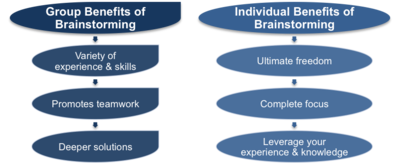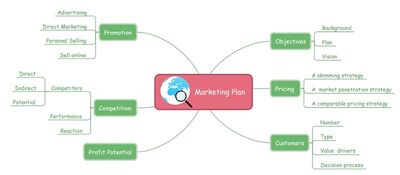Brainstorming
Brainstorming is one of the most creative ways of problem-solving in which we work on ideas. We can either come up with a new idea or build on an existing idea as well. Since there is no rule of thumb in brainstorming, it can be applied individually or in a group.
- Firstly, a goal is defined to understand what the main purpose of brainstorming is.
- Once we have an end-goal to achieve or a problem to solve, various challenges that come along are explored.
- Furthermore, different aspects of the problem or situation are explored and we list down ways to overcome the challenges.
- There is no structure in brainstorming, and no idea is considered wrong. All ideas are noted during the brainstorming sessions, and some can even be clubbed together.
Let’s consider that you need to work on a marketing plan for your brand. Firstly, you will define its objective and the vision of the brand. Subsequently, you will work on other things like the promotional strategy, what the customers think, the pricing, and what your competitors are doing. After considering all these things in mind, you can come up with a new and exciting marketing plan.[1]
Origin of Brainstorming
Advertising executive Alex F. Osborn began developing methods for creative problem-solving in 1939. He was frustrated by employees’ inability to develop creative ideas individually for ad campaigns. In response, he began hosting group-thinking sessions and discovered a significant improvement in the quality and quantity of ideas produced by employees. He first termed the process as organized ideation and was later dubbed by participants as "brainstorm sessions", taking the concept after the use of "the brain to storm a problem." During the period when Osborn made his concept, he started writing on creative thinking, and the first notable book where he mentioned the term brainstorming is "How to Think Up" in 1942. Osborn outlined his method in the 1948 book Your Creative Power in chapter 33, "How to Organize a Squad to Create Ideas".
One of Osborn's key recommendations was for all the members of the brainstorming group to be provided with a clear statement of the problem to be addressed prior to the actual brainstorming session. He also explained that the guiding principle is that the problem should be simple and narrowed down to a single target. Here, brainstorming is not believed to be effective in complex problems because of a change in opinion over the desirability of restructuring such problems. While the process can address the problems in such a situation, tackling all of them may not be feasible.
The Principles of Brainstorming[2]
While brainstorming has evolved over the years, Osborne’s four underlying principles are a great set of guidelines when running your own sessions. These principles include:
- Quantity over quality. The idea is that quantity will eventually breed quality as ideas are refined, merged, and developed further.
- Withhold criticism. Team members should be free to introduce any and all ideas that come into their heads. Save feedback until after the idea collection phase so that “blocking” does not occur.
- Welcome the crazy ideas. Encouraging your team members to think outside of the box, and introduce pie in the sky ideas opens the door to new and innovative techniques that may be your ticket for success.
- Combine, refine, and improve ideas. Build on ideas, and draw connections between different suggestions to further the problem solving process.
Brainstorming Considerations[3]
- When possible, have a separate facilitator and recorder. The facilitator should act as a buffer between the group and the recorder(s), keeping the flow of ideas going and ensuring that no ideas get lost before being recorded. The recorder should focus on capturing the ideas.
- The recorder should try not to rephrase ideas. If an idea is not clear, ask for a rephrasing that everyone can understand. If the idea is too long to record, work with the person who suggested the idea to come up with a concise rephrasing. The person suggesting the idea must always approve what is recorded.
- Keep all ideas visible. When ideas overflow to additional flipchart pages, post previous pages around the room so all ideas are still visible to everyone.
- The more ideas the better. Studies have shown that there is a direct relationship between the total number of ideas and the number of beneficial, creative ideas.
- Allow for and encourage creative, unconventional and out-of-the-box ideas.
- Don’t be afraid to piggyback or build on someone else’s idea.
Individual Brainstorming Vs. Group Brainstorming[4]
Individual Brainstorming
While group brainstorming is often more effective at generating ideas than normal group problem solving, several studies have shown that individual brainstorming produces more – and often better – ideas than group brainstorming.
This can occur because groups aren't always strict in following the rules of brainstorming, and bad behaviors creep in. Mostly, though, this happens because people pay so much attention to other people that they don't generate ideas of their own – or they forget these ideas while they wait for their turn to speak. This is called "blocking."
When you brainstorm on your own, you don't have to worry about other people's egos or opinions, and you can be freer and more creative. For example, you might find that an idea you'd hesitate to bring up in a group develops into something special when you explore it on your own.
However, you may not develop ideas as fully when you're on your own, because you don't have the wider experience of other group members to draw on.
Individual brainstorming is most effective when you need to solve a simple problem, generate a list of ideas, or focus on a broad issue. Group brainstorming is often more effective for solving complex problems.
Some of the key benefits of individual brainstorming are as follows –
- Ultimate freedom. Even when all members of a group are instructed to be as supportive as possible, there is still bound to be some judgment and criticism within the process. That won’t be a problem with individual brainstorming, however, as you will be free to record any and all ideas that come to mind.
- Rather than being distracted by the conversation and activity of the group as a whole, you can focus in on the task at hand when you brainstorm on an individual basis.
- Leverage your experience. If you have detailed experience with a specific problem that needs to be solved, it may be best to brainstorm solutions to that problem all on your own. After all, you have the experience and knowledge necessary, so it should be just a matter of time until you find a proper solution.

source: Free Management e-Books
Group Brainstorming
Here, you can take advantage of the full experience and creativity of all team members. When one member gets stuck with an idea, another member's creativity and experience can take the idea to the next stage. You can develop ideas in greater depth with group brainstorming than you can with individual brainstorming.
Another advantage of group brainstorming is that it helps everyone feel that they've contributed to the solution, and it reminds people that others have creative ideas to offer. It's also fun, so it can be great for team building!
Group brainstorming can be risky for individuals. Unusual suggestions may appear to lack value at first sight – this is where you need to chair sessions tightly, so that the group doesn't crush these ideas and stifle creativity.
Where possible, participants should come from a wide range of disciplines. This cross-section of experience can make the session more creative. However, don't make the group too big: as with other types of teamwork, groups of five to seven people are usually most effective.
Of course, there are plenty of benefits to be noted when talking about group brainstorming as well, such as the points on the list below –
- Variety of backgrounds. When brainstorming as a group, you will have access to the various experiences of all members of the group, so you will be more likely to stumble on a quality idea or solution. An idea that may have been missed by an individual brainstorming just may be found by the group.
- Promote teamwork. Every organization can benefit from bringing its team together to work toward a common goal. By having a productive team brainstorming session from time to time, you will be able to build morale and allow everyone to feel like they are having input in the process.
- Deeper solutions. Once someone within the group brainstorming session comes across a good idea, others in the group may be able to expand on the idea in order to come up with a thorough, complex answer to the problem at hand.
See Also
Six Thinking Hats
Rätselvermehrung
Problem Analysis Tree
Metaplan Method
Mind Mapping
Bisociation
SHARP (Structured, Holistic Approach for a Research Proposal)
References
- ↑ Definition - What Does Brainstorming Mean? Mindmaster
- ↑ The four principles of brainstorming Mind Manager
- ↑ Brainstorming Considerations Asq.org
- ↑ Individual Brainstorming Vs. Group Brainstorming Mindtools

